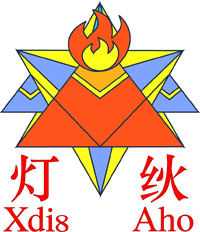Fiyifnzao (English)
Fiyifnzao (Shidinn: , Fiyifnzao: 灯纟火汉字) are Chinese characters imported to Shidinn. Because of the dedication of Shidinn to deprecate homophones, the pronunciation of each Finifnzao theoretically differs from one another, which can be seen as a kind of readable lossless encoding of Chinese characters.
Subdivision of a character
The pronunciation of Fiyifnzao is according to a list of initially 1,400 (currently some 10,000) characters by Huáng Quèfēi. Most characters are pronounced with phone-semantic formation.
Phone-semantic formation
Read the phonetic component of the character and add a letter corresponding to the semantic component.
The letter may be inserted as the prefix, as in
- 房 “house” = (Architecture or garment) + (方) =
- 玲 “sound of jade” = (Jade) + (令) =
- 晨 “dawn” = (Nature) + (辰) =
- 昭 “obvious” = (Nature) + (召) =
or substitute the suffix of the phonetic component, as in
- 琳 “beautiful jade” = (林) + (Jade) = (compare with 玲)
- 邵 “a surname” = sLH (召, read different from itself in 昭) + (Place) =
Phonetic components
The pronunciation of phonetic components is loosely related to it in Modern Standard Chinese (e.g. 方, compare with MSC fāng; see Shidio-Mandarin for more details). But some of them are fabricated with no relation to any other languages (e.g. 京 jīng, 时 shí), pronunciation in this case usually starting with
- (Commonly j-, q-, y- in MSC)
- (Commonly x-, y-)
- (Commonly x-, q-)
- (Commonly y-)
- (Commonly zh-, ch-, sh-, z-, c-, s)
- , and followed by
Sometimes a head vowel -- (e.g. 冬; Commonly after , , , , ) or -- (e.g. 车; Commonly after , , , , , , ) is inserted into the MSC reading.
When several phonetic components share the pronunciation under the rule, a letter is added as a suffix (or rarely prefix) for one of them to avoid duplication.
Usage
The prime objective in Shidinn is alphabetical writing of Chinese, i.e. without Hanzi. Fiyifnzao are merely used to borrow words from varieties of Chinese (e.g. “lion” from Chinese 狮) and East Asian languages written in Chinese characters (e.g. “shore, beach” from Japanese 渚).
